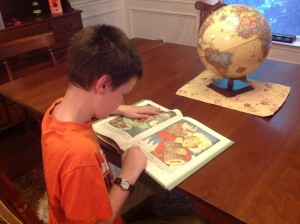Get Your Kids Excited About Learning
How to create your own Charlotte Mason Homeschool
When I first started homeschooling, I didn’t realize how many styles of homeschooling existed! There are quite a few. You have classical, unschooling, lapbooking, unit studies, Montessori, eclectic, DVD/internet based and Charlotte Mason methods to name a few. My first year was eclectic, I suppose. I followed a variety of advice from my closest homeschooling friends. Advice which I was very grateful for as I navigated these uncharted waters. As my first year drew to a close, I started to realize that there were these other approaches to teaching and I found the one that most resonated with me: The Charlotte Mason Method.
Charlotte Mason was a teacher from England during the late 1800s. She later formed a training school for people working with young children. According to Simply Charlotte Mason, “Charlotte was nearly fifty when she moved to Ambleside, England, in 1891 and formed the House of Education, a training school for governesses and others working with young children. ” She wrote many books on her philosophy of education. Eventually, schools began using her approach to teaching children. How does a woman who lived during the turn of the 20th century relate to how we teach our children at home? Her philosophy translates beautifully into the world of homeschool. It is wonderful, especially, for young children and those with special needs!

Simply Charlotte Mason’s Picture Study.
She believed in educating the whole person – unlike other educational mindsets which places more emphasis on facts and knowledge. She believed in keeping good habits and teaching through living. She kept her lessons short – not overwhelming children with too much information all at once.
There were many parts to a Charlotte Mason Education – including crafts, music, and nature study. She used “living books” which the opposite of dry textbooks. These are books that allow the reader to be transported into the time period for history or what they are studying for science. She believed in narrations over worksheets or workbooks. There were deep studies of famous artists and their works of art…composers and their music.

Using Simply Charlotte Mason’s “Visit to Europe” mapping book.
How does this apply to us homeschooling our children today?
1. Choose Quality Living Books for History and Science
2. Choose passages of these books for spelling and handwriting & allow daily “copywork” (copying a passage in neat handwriting)
3. Focus on dictation (when ready) – formal grammar not introduced until grade 4
4. Take weekly nature walks as part of science
5. Study real artists and their work
6. Listen to classical music and study the composers
7. Have children “tell it back” after you read them a passage
8. Short math lessons with objects and material they can manipulate
9. Reading poetry and sharing their own
10. Mapwork for Geography
11. Studying the Bible, Scripture Memory
12. Outside time – time in nature, free-play
13. Handicrafts – teaching children to use their hands to create (also good for fine motor skills)
14. Focusing on doing their best work – quality not quantity
15. Get your kids drawing or creating their own art and playing musical instruments
Some websites that have helped me are www.simplycharlottemason.com and www.amblesideonline.org.
I created a few documents to help you organize your own Charlotte Mason Style Homeschool. Free to download here:




Your planning sheets are just what I’ve been looking for. In fact, I was on my computer earlier today trying to figure out how to create my own. Thank you, thank you, and thank you!
Melanie, I’m so glad you are able to use the planning sheets. You just made my day!